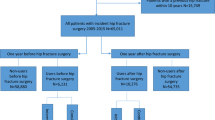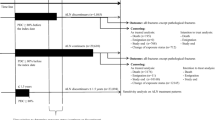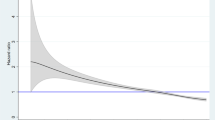Abstract
Summary
Alendronate is effective in preventing second hip fracture in osteoporotic patients. However, no consensus exists on the duration that is effective in preventing a second hip fracture. Our study demonstrated that risk can be reduced when the prescription is ≥ 6 months for the year following the index hip fracture.
Introduction
Alendronate is effective in preventing second hip fracture in osteoporotic patients. However, no consensus exists on the accurate medication possession ratio (MPR) that is effective in preventing a second hip fracture. Our objective was to compare the risk of second hip fracture in patients treated with different MPR of alendronate.
Methods
In this population-based cohort study, data from National Health Insurance Research Database of Taiwan were analyzed. Patients 50 years and older who had an index hip fracture and were not receiving any osteoporotic medications before their fracture during 2000–2010 were included. The cohort consisted of 88,320 patients who were new alendronate users (n = 9278) and non-users (n = 79,042). Those without alendronate were matched 4:1 as the control group. Patients were subdivided into those with no medication, MPR < 25%, MPR 25–50%, MPR 50–75%, and MPR 75–100%. Cox proportional hazard models were used to calculate the adjusted hazard ratios for different MPRs of alendronate.
Results
After matching, 38,675 patients were included in this study; 20,363 (52.7%) were women, and 30,940 (80%) patients were without medication of alendronate. During follow-up on December 31, 2012, 2392 patients had a second hip fracture, for an incidence of 1449/100,000 person-years. Patients with alendronate MPR 50–75% had a lower risk of a second hip fracture compared to non-users (hazard ratio 0.66). When the MPR increased to 75–100%, the hazard ratio decreased to 0.61.
Conclusions
In this population-based cohort study, risk of a second hip fracture can be reduced when the alendronate MPR is ≥ 50% for the year following the index hip fracture. As the MPR increases, the risk of a second hip fracture decreases.

Similar content being viewed by others
References
Colon-Emeric CS, Sloane R, Hawkes WG, Magaziner J, Zimmerman SI, Pieper CF et al (2000) The risk of subsequent fractures in community-dwelling men and male veterans with hip fracture. Am J Med 109:324–326
Klotzbuecher CM, Ross PD, Landsman PB, Abbott TA 3rd, Berger M (2000) Patients with prior fractures have an increased risk of future fractures: a summary of the literature and statistical synthesis. J Bone Miner Res 15:721–739
Gallagher AM, Rietbrock S, Olson M, van Staa TP (2008) Fracture outcomes related to persistence and compliance with oral bisphosphonates. J Bone Miner Res 23:1569–1575
Gold DT, Martin BC, Frytak JR, Amonkar MM, Cosman F (2007) A claims database analysis of persistence with alendronate therapy and fracture risk in post-menopausal women with osteoporosis. Curr Med Res Opin 23:585–594
Nguyen ND, Eisman JA, Nguyen TV (2006) Anti-hip fracture efficacy of biophosphonates: a Bayesian analysis of clinical trials. J Bone Miner Res 21:340–349
Siris ES, Harris ST, Rosen CJ, Barr CE, Arvesen JN, Abbott TA, Silverman S (2006) Adherence to bisphosphonate therapy and fracture rates in osteoporotic women: relationship to vertebral and nonvertebral fractures from 2 US claims databases. Mayo Clin Proc 81:1013–1022
Keshishian A, Boytsov N, Burge R, Krohn K, Lombard L, Zhang X, Xie L, Baser O (2017) Examining the effect of medication adherence on risk of subsequent fracture among women with a fragility fracture in the U.S. Medicare population. J Manag Care Spec Pharm 23:1178–1190
Lee YK, Ha YC, Choi HJ, Jang S, Park C, Lim YT, Shin CS (2013) Bisphosphonate use and subsequent hip fracture in South Korea. Osteoporos Int 24:2887–2892
Lyles KW, Colon-Emeric CS, Magaziner JS, Adachi JD, Pieper CF, Mautalen C et al (2007) Zoledronic acid and clinical fractures and mortality after hip fracture. N Engl J Med 357:1799–1809
Morin S, Rahme E, Behlouli H, Tenenhouse A, Goltzman D, Pilote L (2007) Effectiveness of antiresorptive agents in the prevention of recurrent hip fractures. Osteoporos Int 18:1625–1632
Peng J, Liu Y, Chen L, Peng K, Xu Z, Zhang D, Xiang Z (2016) Bisphosphonates can prevent recurrent hip fracture and reduce the mortality in osteoporotic patient with hip fracture: a meta-analysis. Pak J Med Sci 32:499–504
Vestergaard P, Rejnmark L, Mosekilde L (2011) Are antiresorptive drugs effective against fractures in patients with diabetes? Calcif Tissue Int 88:209–214
Cramer JA, Amonkar MM, Hebborn A, Altman R (2005) Compliance and persistence with bisphosphonate dosing regimens among women with postmenopausal osteoporosis. Curr Med Res Opin 21:1453–1460
Lee YK, Ha YC, Yoon BH, Koo KH (2013) Incidence of second hip fracture and compliant use of bisphosphonate. Osteoporos Int 24:2099–2104
Olsen KR, Hansen C, Abrahamsen B (2013) Association between refill compliance to oral bisphosphonate treatment, incident fractures, and health care costs--an analysis using national health databases. Osteoporos Int 24:2639–2647
Wang YH, Kung PT, Tsai WC, Tai CJ, Liu SA, Tsai MH (2012) Effects of multidisciplinary care on the survival of patients with oral cavity cancer in Taiwan. Oral Oncol 48:803–810
McCombs JS, Thiebaud P, McLaughlin-Miley C, Shi J (2004) Compliance with drug therapies for the treatment and prevention of osteoporosis. Maturitas 48:271–287
Hawley S, Leal J, Delmestri A, Prieto-Alhambra D, Arden NK, Cooper C, Javaid MK, Judge A, REFReSH Study Group (2016) Anti-osteoporosis medication prescriptions and incidence of subsequent fracture among primary hip fracture patients in England and Wales: an interrupted time-series analysis. J Bone Miner Res 31:2008–2015
Brozek W, Reichardt B, Zwerina J, Dimai HP, Klaushofer K, Zwettler E (2016) Antiresorptive therapy and risk of mortality and refracture in osteoporosis-related hip fracture: a nationwide study. Osteoporos Int 27:387–396
Bondo L, Eiken P, Abrahamsen B (2013) Analysis of the association between bisphosphonate treatment survival in Danish hip fracture patients-a nationwide register-based open cohort study. Osteoporos Int 24:245–252
Lawrence TM, Wenn R, Boulton CT, Moran CG (2010) Age-specific incidence of first and second fractures of the hip. J Bone Joint Surg Br 92:258–261
Lin TC, Yang CY, Yang YH, Lin SJ (2011) Alendronate adherence and its impact on hip-fracture risk in patients with established osteoporosis in Taiwan. Clin Pharmacol Ther 90:109–116
Osaki M, Tatsuki K, Hashikawa T, Norimatsu T, Chiba K, Motokawa S, Furuichi I, Doiguchi Y, Aoyagi K, Shindo H (2012) Beneficial effect of risedronate for preventing recurrent hip fracture in the elderly Japanese women. Osteoporos Int 23:695–703
Shen SH, Huang KC, Tsai YH, Yang TY, Lee MS, Ueng SW, Hsu RW (2014) Risk analysis for second hip fracture in patients after hip fracture surgery: a nationwide population-based study. J Am Med Dir Assoc 15:725–731
Soong YK, Tsai KS, Huang HY, Yang RS, Chen JF, Wu PC, Huang KE (2013) Risk of refracture associated with compliance and persistence with bisphosphonate therapy in Taiwan. Osteoporos Int 24:511–521
Funding
This study is based on data from the National Health Insurance Research Database provided by the Bureau of National Health Insurance, Department of Health, Taiwan. This work was supported by China Medical University (grant numbers: CMU107-S-02).
Author information
Authors and Affiliations
Corresponding author
Ethics declarations
Conflicts of interest
None.
Additional information
Publisher’s note
Springer Nature remains neutral with regard to jurisdictional claims in published maps and institutional affiliations.
Rights and permissions
About this article
Cite this article
Chen, Y., Kung, P., Chou, W. et al. Alendronate medication possession ratio and the risk of second hip fracture: an 11-year population-based cohort study in Taiwan. Osteoporos Int 31, 1555–1563 (2020). https://doi.org/10.1007/s00198-020-05399-9
Received:
Accepted:
Published:
Issue Date:
DOI: https://doi.org/10.1007/s00198-020-05399-9




